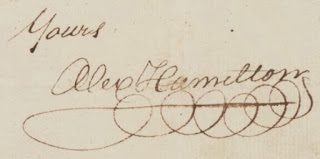When Alexander Wished for a War
On 11 Nov 1769, a young clerk on the island of St. Croix wrote to his friend Edward Stevens, who had headed off to King’s College in New York.
Earlier this year the Library of Congress made its Hamilton Papers available online, as explained here. This 1769 letter, for example, can be viewed here.
Another source of new perspectives on Hamilton is Michael E. Newton’s blog Discovering Hamilton, which will roll out new documents and theories over time.
As to what you say respecting your having soon the happiness of seeing us all, I wish, for an accomplishment of your hopes provided they are Concomitant with your welfare, otherwise not, tho doubt whether I shall be Present or not for to confess my weakness, Ned, my Ambition is prevalent that I contemn the grov’ling and condition of a Clerk or the like, to which my Fortune &c. condemns me and would willingly risk my life tho’ not my Character to exalt my Station.The clerk who wrote this letter was Alexander Hamilton. He was either twelve or fourteen years old at the time; on reaching North America he consistently stated that he was born in 1757, but some earlier documents from the Caribbean suggest he was born in 1755 and thus revised his age in college to appear to be more of a prodigy. Whichever age Alexander was at this time, his letter is remarkable for its frank ambition.
Im confident, Ned that my Youth excludes me from any hopes of immediate Preferment nor do I desire it, but I mean to prepare the way for futurity. Im no Philosopher you see and may be jusly said to Build Castles in the Air. My Folly makes me ashamd and beg youll Conceal it, yet Neddy we have seen such Schemes successfull when the Projector is Constant I shall Conclude saying I wish there was a War.
Earlier this year the Library of Congress made its Hamilton Papers available online, as explained here. This 1769 letter, for example, can be viewed here.
Another source of new perspectives on Hamilton is Michael E. Newton’s blog Discovering Hamilton, which will roll out new documents and theories over time.


No comments:
Post a Comment